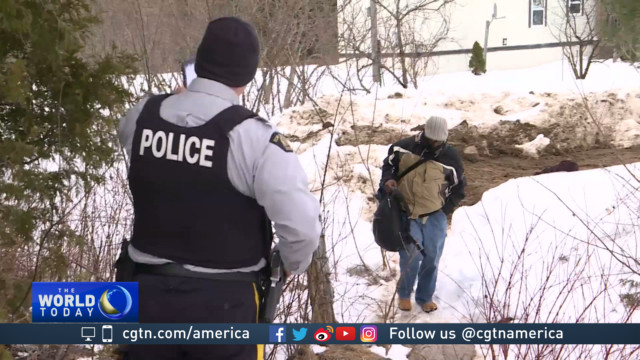Canada has seen a surge of asylum seekers crossing the border from the U.S. It comes in the wake of U.S. President Donald Trump’s election. Many of the migrants fear being sent back to Africa or the Middle East.
CGTN’s Karina Huber reports from the border.

For one asylum seeker from Eritrea, getting arrested is just part of the process to hopefully become a Canadian citizen.
If he has his identification papers and appears not to pose a security risk, he will be taken to the official border nearby to file his refugee claim.
Scenes like these have spiked dramatically across Canada in recent months.
Asylum seekers – mainly from Africa and the Middle East – have been braving cold temperatures, crossing from the U.S. into Canada on foot, often with young families in tow.
Experts say the increase is driven in part by the feeling that, in Trump’s America, foreigners – especially Muslims – aren’t welcome.
At the same time, Canada’s new Prime Minister Justin Trudeau recently sent a tweet encouraging refugees to come to Canada.
It caught the world’s attention.
In the first two months of 2017, Canadian police intercepted 1,134 asylum seekers entering through unofficial border crossings.
That’s almost half the amount apprehended in all of 2016.
This dead-end road near the rural town of Hemmingford, Quebec has become a hotspot for asylum seekers crossing from the U.S. into Canada.
Why here? Ease of entry.
All they have to do is walk along a path and they’re potentially on their way to starting a new life.
Immigration experts say roughly 65 percent of initial asylum claims are approved. Reaction among Canadians is mixed.
A recent poll showed nearly half of Canadians would like to deport those entering Canada illegally from the United States.
But are the crossings illegal? Canadian police and Canada Border Services Agency refer to them as illegal, but some immigration lawyers disagree.
“There’s absolutely no charges. Absolutely not. That would be a violation of both international and Canadian law,” said Mitchell Goldberg the President of the Canadian Association of Refugee Lawyers.
Goldberg says asylum seekers crossing from the United States would prefer to go through official ports of entry, but can’t. The Canada-U.S. Safe Third Country Agreement denies them access and requires they be sent back to the U.S. to apply for asylum there.
“It only applies to the official border crossings. So if somebody comes in by foot ten meters away they are eligible for a refugee claim,” says Mitchell.
Legal or not, residents living near the Quebec-New York border have generally been welcoming to the refugees.
The Canadian police are also taking a sympathetic approach often bringing car seats, warm clothes and toys for the kids.
The Royal Canadian Mounted Police will likely be busy apprehending asylum seekers for a while.
With the warm weather approaching, crossings like these are expected to increase.
 CGTN America
CGTN America

